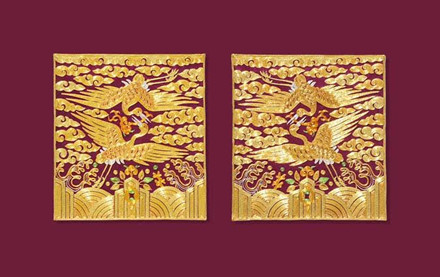Korean Embroidery
Lee Jung Hee, an artist from the Republic of Korea, is famous for her sophisticated embroidered pieces. Lee started doing this royal art when she was seventeen. She has overcome a physical disability and made a great effort to pursue this traditional art of embroidery, receiving the Presidential Award for “Disabled People in Arts and Culture” in 2013. She has become a key figure in preserving and promoting traditional Korean culture. Lee is visiting Vietnam for the first time to show her 44 embroidered works of art featuring South Korea’s royal embroidery techniques at an exhibit at 47 Nguyen Du Street. On the first day of the exhibit, the artist also demonstrated a number of traditional Korean embroidery techniques. Lee said: “For an artist, every work of art is a masterpiece. Every embroidered piece is a different experience, so it’s hard to say which one’s my favorite. But the most special one is the curtain entitled “green dragon white tiger”, which features mountains and clouds with a dragon and a tiger facing each other. This piece took me three years to finish.”

Embroidery is the art of decorating fabric with a needle and thread. In order to introduce Korean Royal embroidery to Vietnamese people, an exhibit of famous South Korean embroidery artist Lee Jung Hee was staged recently in Hanoi. The Korean cultural center is running the exhibition to introduce the beauty of traditional Korean art.
“Green Dragon white tiger” is the biggest work of art in this exhibit, and also the largest piece in Lee Jung Hee’s 30 year career. The curtain measures 50cm by180cm and took her three years of working 12-hour days to finish. Learning embroidery requires patience, time, love, and passion. Even a small flower takes 2 to 3 hours to embroider. For this reason, royal embroidery is not a common art in Korea. Lee said: “Korean royal embroidery started developing in the feudal period and was reserved only for member of the royal family or high-ranking officials. Nowadays, anyone can have the opportunity to learn this royal art. Korean artists have created many diverse embroidery techniques, which can be used in both traditional and contemporary designs. When an artist starts embroidering, she will look at the whole picture and decide which techniques to use.”
During her visit to Vietnam, Lee also paid visits to some famous embroidery villages around Hanoi to see the similarities and differences between embroidery techniques in Vietnam and Korea. She said: “There is a big difference between Vietnamese and Korean embroidery art. When looking at the traditional Vietnamese traditional patterns, it seem like all the objects, animals, and plants are real, whereas the Korean royal embroidery art often symbolizes these motifs to give longevity, luck, and wealth. Another difference is the colors that are used. In Korea, there are some special colors and high-quality materials that were used only for members of the royal family such as red, yellow or golden stitches.”
Korean royal embroidery is a splendid and elegant combination of not only skill but also patience, creativity and love. However, the survival of Korean royal embroidery is under threat due to the lack of attention from younger generations. Regarding her effort to preserve and promote this kind of art, Lee said: “It seems like older people or artisans like me now pay more attention to embroidery art. I want to preserve and promote this precious art by finding and training more and more young people. I know it is not a simple task, but I will do my best to draw the attention of younger generations to this art.”

Through this exhibit, Lee hopes that Vietnamese visitors will learn more about Korean embroidery arts and the similarities and differences between the art of embroidery in Vietnam and the Republic of Korea. Kim Huyen Trang, a Korean culture lover, said: “My younger sister loves embroidery, so I am taking her to the exhibit today. I myself know little about embroidery in general, but the works of artist Lee Jung Hee really impress me. It is really hard to embroider such meticulous pieces. They must have required a lot of patience and time. The works tell me more about Korean people’s characteristics.”
In Korea, the patterns or symbols on the clothes showed the wearer’s rank in society. A dragon embroidered with valuable thread appeared on the chest, back, and shoulders of the King and Crown Prince’s costumes to represent power. A phoenix represented the queen, while Princesses and royal concubines wore floral patterns. High ranking court officials wore patterns with clouds and cranes. These patterns symbolize longevity, luck, and wealth, according to Korean culture.


Le Ha Phuong Linh, who has experience in making Vietnamese embroidery patterns, could not hide her emotion when seeing Lee’s art. She said: “When seeing each piece at this exhibit, I can feel the smoothness of the fabrics as well as the stitches. The materials and the artist’s embroidery techniques make the works lively and beautiful. Korean and Vietnamese royal embroidery art both showcase the beauty of the two nations’ cultures. I love these pieces so much.”
Many other products in the daily life of Koreans, such as embroidered clothes, ties, pillows, tablecloths, and embroidered objects, are also shown at the 3-day exhibit, The positive response from the audience is a good motivation for the artist to continue preserving and promoting this precious royal embroidery art.
Viet Anh




